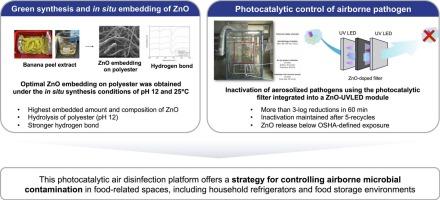光催化zno掺杂聚酯过滤器用于减少储存环境中食源性病原体的空气交叉污染
IF 8
1区 农林科学
Q1 FOOD SCIENCE & TECHNOLOGY
引用次数: 0
摘要
有效的空气净化对于控制空气污染至关重要,特别是在微生物交叉污染可能危及食品安全的食品储存环境中。传统的过滤方法往往受到微生物积累的影响,导致效率下降和潜在的再污染。本研究以香蕉皮提取物为原料,采用绿色法合成了一种掺杂氧化锌纳米粒子的聚酯基无纺布过滤器。采用填料和原位合成两种包埋方法对pH和温度进行优化,以增强纳米颗粒的沉积和抗菌活性。原位合成的最佳条件为pH为12,温度为25°C,在UVA照射下具有优异的ZnO负载和光催化活性。将掺杂zno的滤光片组装到UVLED模块中,在模拟冰箱条件的512 L空气生物学室中,对雾化的食源性病原体,大肠杆菌O157:H7,鼠伤寒沙门氏菌和单核增生李斯特菌减少了3倍以上。利用SEM和FT-IR进行结构表征,证实纳米颗粒分布均匀,在聚酯基体内嵌入稳定。开发的zno掺杂聚酯过滤器提供了强大的可重复使用的空气净化能力,突出了它们作为可持续和有效的解决方案的潜力,以提高食品保存环境中的微生物安全。本文章由计算机程序翻译,如有差异,请以英文原文为准。

Photocatalytic ZnO-doped polyester filters for reducing airborne cross-contamination by foodborne pathogens in storage environments
Effective air purification is crucial for controlling airborne contamination, especially in food storage environments where microbial cross-contamination can compromise food safety. Conventional filtration methods often suffer from microbial accumulation, leading to decreased efficiency and potential recontamination. This study aimed to develop a polyester-based nonwoven filter doped with zinc oxide nanoparticles (ZnO NPs) synthesized using a green method involving banana peel extract. Two embedding methods, padding and in situ synthesis, were optimized for pH and temperature to enhance nanoparticle deposition and antimicrobial activity. The optimal conditions were determined to be pH 12 at 25 °C for in situ synthesis, achieving superior ZnO loading and photocatalytic activity under UVA irradiation. ZnO-doped filters were assembled into the UVLED module in a 512 L aerobiology chamber simulating refrigerator conditions, achieving more than 3-log reduction against aerosolized foodborne pathogens, Escherichia coli O157:H7, Salmonella Typhimurium, and Listeria monocytogenes. Structural characterization using SEM and FT-IR confirmed uniform nanoparticle distribution and stable embedding within the polyester matrix. The developed ZnO-doped polyester filters provide robust and reusable air purification capabilities, highlighting their potential as sustainable and effective solutions for improving microbial safety in food preservation environments.
求助全文
通过发布文献求助,成功后即可免费获取论文全文。
去求助
来源期刊

Food Research International
工程技术-食品科技
CiteScore
12.50
自引率
7.40%
发文量
1183
审稿时长
79 days
期刊介绍:
Food Research International serves as a rapid dissemination platform for significant and impactful research in food science, technology, engineering, and nutrition. The journal focuses on publishing novel, high-quality, and high-impact review papers, original research papers, and letters to the editors across various disciplines in the science and technology of food. Additionally, it follows a policy of publishing special issues on topical and emergent subjects in food research or related areas. Selected, peer-reviewed papers from scientific meetings, workshops, and conferences on the science, technology, and engineering of foods are also featured in special issues.
 求助内容:
求助内容: 应助结果提醒方式:
应助结果提醒方式:


